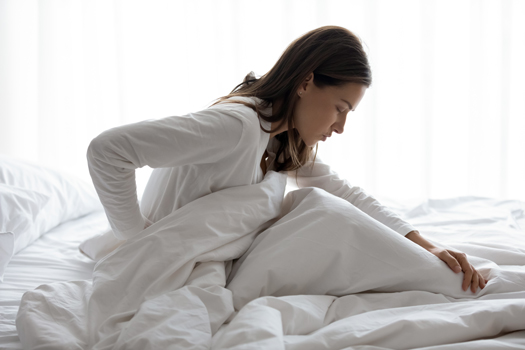
Since your lower back is the most mobile and exposed part of your spine, it's the area where discs are more likely to become herniated. The biomechanical forces at play in this flexible part of your spine are the main reason this is the case. Today, we look closer into what's going on with your lumbar spine and discuss the most common disc to herniate and a nearby area also likely to be affected.
The Fourth-Fifth Lumbar Vertebrae
Disc herniation tends to occur more often in the lower back area between the fourth and fifth lumbar vertebrae, according to Johns Hopkins Medicine. Also referred to as the L4 and L5 spinal bones, these are the lowest fully mobile vertebrae in the lower spine. The reason the disc between these two spinal bones is more susceptible to herniation is due to the pressure typically applied to this area. According to Spine Health, this spinal motion segment is at higher risk for degeneration, in part, because it helps with a wide range of functions. These include:
• Supporting the upper body
• Turning, bending, twisting, and other trunk-related motions
• Making multidirectional movements
The disc situated here is also close to the sciatic nerve. The longest nerve in the body, it starts at the base of the spine and continues downward. Its close proximity to the disc between the fourth and fifth lumbar vertebrae means protruding disc material could potentially affect this nerve, which could contribute to numbness, tingling, and similar characteristic symptoms of disc herniation.
The Sacral Spine
Another common herniation area in the lower back, according to Johns Hopkins Medicine, is a section of the lower spine where the lumbar and sacral sections meet called the lumbar-sacral junction. There are five sacral spinal bones that fuse or join together to form a structure referred to as the sacrum. The top section of these fused bones is called S1. Ninety percent of all lower back herniations occur at the L4-5 and L5-S1 levels.
Identifying Disc-Related Problems in Vulnerable Areas
Because discs more likely to become herniated are within the lower portion of the spine, it's not always easy to conclusively tell if there's a problem with one of these discs. The reason is because there are other possible sources of similar symptoms in this area. For instance, soft tissues in the lower back could become irritated enough to affect nearby nerves. Spinal bones and joints could also contribute to nerve irritation. For this reason, it's important to get an accurate diagnosis if disc herniation is suspected. Doing so as soon as disruptive symptoms are noticed increases your odds of responding well to treatment recommendations. Typically, signs of a herniated lower spine disc include:
• Lower back pain that gets worse with movement or certain actions like coughing
• Discomfort that extends into the lower body and may affect one side worse than the other
• Muscle weakness within the lower back area that may extend lower
• Tingling sensations and/or numbness
If you have a herniated disc in your lower back that isn't responding to conservative treatment, a lumbar discectomy may be the best option. Although this is generally a very successful procedure, having a large hole in the outer ring of the disc more than doubles the risk of needing another operation. A new treatment, Barricaid, is a bone-anchored device that closes this hole, and in a large study, 95 percent of Barricaid patients didn’t undergo a reoperation due to reherniation in the 2-year study timeframe. This treatment is done immediately following the discectomy—during the same operation—and doesn’t require any additional incisions or time in the hospital.
If you have any questions about the Barricaid treatment, ask your doctor or contact us at 844-288-7474.
For full benefit/risk information, please visit: https://www.barricaid.com/instructions.


Comments